
Laramie is a city in and the county seat of Albany County, Wyoming, United States. The population was estimated 32,711 in 2019, making it the third-largest city in Wyoming after Cheyenne and Casper. Located on the Laramie River in southeastern Wyoming, the city is north west of Cheyenne, at the junction of Interstate 80 and U.S. Route 287.

Fort D. A. Russell, also known as Fort Francis E. Warren, Francis E. Warren Air Force Base and Fort David A. Russell, was a post and base of operations for the United States Army, and later the Air Force, located in Cheyenne, Wyoming. The fort had been established in 1867 to protect workers for the Union Pacific Railroad. It was named in honor of David Allen Russell, a Civil War general killed at the Battle of Opequon. In 1930, the fort's name was changed to Fort Francis E. Warren. In 1949, it became Francis E. Warren Air Force Base.
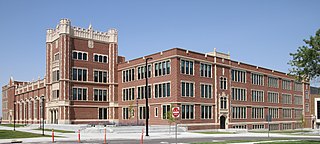
Natrona County High School (NCHS) is a public secondary school located in Casper, Wyoming, United States. It serves Natrona County School District #1, which encompasses all of Natrona County, Wyoming.
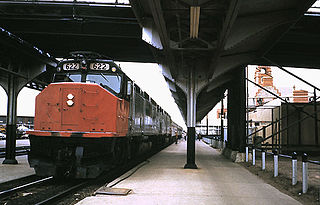
The Cheyenne Depot Museum is a railroad museum in Cheyenne, Wyoming. It is located inside the historic Union Pacific Railroad depot, built in the 1880s. The depot, a National Historic Landmark, was the railroad's largest station west of Council Bluffs, Iowa, and a major western example of Richardsonian Romanesque architecture.

Cheyenne is the capital and most populous city of the U.S. state of Wyoming, with 65,132 residents. It is the principal city of the Cheyenne metropolitan statistical area which encompasses all of Laramie County and has about 100,000 residents. Local residents named the town for the Cheyenne Native American people in 1867 when it was founded in the Dakota Territory.
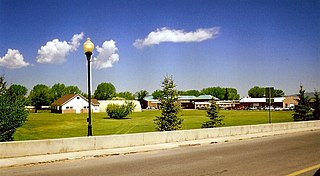
The Wyoming State Hospital, once known as the Wyoming State Insane Asylum, is located in Evanston, Wyoming, United States. The historic district occupies the oldest portion of the grounds and includes fifteen contributing buildings, including the main administrative building, staff and patient dormitories, staff apartments and houses, a cafeteria and other buildings, many of which were designed by Cheyenne, Wyoming architect William Dubois. Established in 1887, the historic buildings span the period 1907-1948. At one point it was common for new hall additions to be named after the counties in Wyoming. The recent addition of Aspen, Cottonwood, and Evergreen halls do not follow this trend.
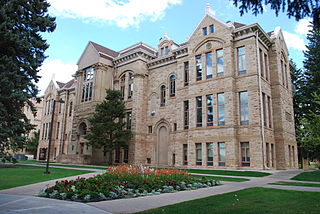
Old Main, built in 1886, was the first and is the oldest remaining building on the University of Wyoming campus, in Laramie, Wyoming. The building currently houses University administration.
The Fort Laramie Three-Mile Hog Ranch was built to serve as a social center away from the soldiers' post at historic Fort Laramie. Fort Laramie was a 19th-century military post in eastern Wyoming. It became notorious as a place for gambling and drinking, and for prostitution, with at least ten prostitutes always in residence. The location is notable as an example of one of only a few military bordellos still standing in the United States by 1974, the time of its nomination to the National Register of Historic Places The Fort Laramie site was one of a number of so-called "hog ranches" that appeared along trails in Wyoming.

There are 73 properties listed on the National Register of Historic Places in Albany, New York, United States. Six are additionally designated as National Historic Landmarks (NHLs), the most of any city in the state after New York City. Another 14 are historic districts, for which 20 of the listings are also contributing properties. Two properties, both buildings, that had been listed in the past but have since been demolished have been delisted; one building that is also no longer extant remains listed.
The University of Arkansas Campus Historic District is a historic district that was listed on the National Register of Historic Places on September 23, 2009. The district covers the historic core of the University of Arkansas campus, including 25 buildings.

The Horace Belden School and Central Grammar School are a pair of architecturally distinguished Late Gothic Revival occupying a single campus at 933 Hopmeadow Street and 29 Massaco Street in Simsbury, Connecticut. The Belden School was built in 1907 as the first Simsbury High School, and now serves as Simsbury Town Hall. The Central Grammar School, built in 1913, is now called the Central School. The buildings were listed as a pair on the National Register of Historic Places in 1993 for their architecture and their role in the town's educational system.

St. Mark's Episcopal Church is a historic church in Cheyenne, Wyoming.
William R. Dubois (1879-1953) was an American architect. He was a prolific architect in Wyoming and nearby states.
Frederic Hutchinson "Bunk" Porter, Sr., sometimes referred to as Frederick Hutchinson Porter, was an American architect based in Cheyenne, Wyoming. He was active from 1911 to approximately 1965. He designed many of Cheyenne's most important public and commercial buildings and also designed several buildings at the University of Wyoming, including War Memorial Stadium and the Agriculture Building. A number of his works are listed on the U.S. National Register of Historic Places.

The City and County Building, also known as the City-County Building, at 19th St. and Carey Ave. in Cheyenne, Wyoming, was built during 1917–1919. It was designed by architect William Dubois in Classical Revival style.
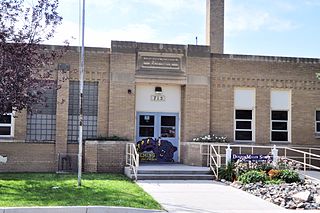
Deming Elementary School is an elementary school in Cheyenne, Wyoming. It is part of the Laramie County School District Number 1. The school was designed by Frederick Hutchinson Porter and built in 1945. It was listed on the National Register of Historic Places in 2005.

Peru High School Historic District is a historic school complex and national historic district located at Peru, Miami County, Indiana. It encompasses the Classical Revival style Central Grade School, Collegiate Gothic style Industrial Arts Building, and Art Deco style former high school. The high school was built as a Works Progress Administration project along with the Tig-Arena and is a two-story masonry building. The school yard is considered a contributing site. The high school remained in use as a high school until the new Peru High School was built in 1969–1971. Since 1990, the buildings have served as headquarters for the Miami Nation of Indiana.

The Laramie Plains Civic Center was established in 1982 in the old East Side School in Laramie, Wyoming. The original portion of the complex was built in 1878 and was the oldest public school building in Wyoming. It was expanded in 1928 and 1939, and closed as a school in 1979. The civic center provides performing, studio and gallery space for visual and performing arts, as well as office and small business space.

The Lincoln School in Laramie, Wyoming was built in 1924 and expanded in 1939 and 1958. Originally called the West Side School, served the less prosperous, largely Hispanic neighborhoods on the west side of Laramie. It was closed in 1978 and became the Lincoln Community Center. It was renovated and expanded in 2012.
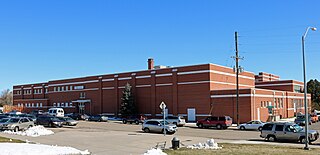
The Johnson Public School, at 711 Warren Ave. in Cheyenne, Wyoming, was built in 1923. It was listed on the National Register of Historic Places in 2005, at which time it was owned by the First Assembly of God Church.


















